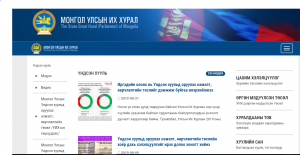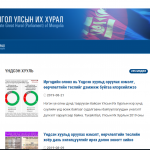By Mendee Jargalsaikhan
Constitutional Revision
Just days before the celebration of the 95th anniversary of the abolition of the monarchy, the MPP-ruled parliament and DP president reached a compromise on a set of amendments to the 1992 constitution. Today, at the celebration, President endorsed these amendments, demonstrating his unity with the Parliamentary Speaker and Prime Minister – but, no representation of the judiciary on the stage.
It was neither an easy nor a thorough process to pass these amendments – especially as all incumbent office holders seem to have focused on ensuring their re-elections.
Electoral System
First, MPs successfully voted against any form of proportional representation. A mixed electoral system (majoritarian and proportional) was introduced prior to the 2012 parliamentary election, but changed back to a majoritarian system before the 2016 election. Despite their success of keeping the majoritarian system, MPs failed to increase the term and number of seats and did not even debate the possibility of reviving a bicameral structure for the legislature.
Direct Presidential Election
Second, the president successfully saved the direct presidential election from going back to pre-1992 practice of electing the president among the elected MPs. This has been and now continues to be the source for the power struggle between a directly-elected parliament and president. Both parliament and president legitimately claim that they are representing the majority of voters. However, the current compromise led to a curtailing of presidential prerogatives over the judiciary and a single six-year term.
Strategic Deposits
Third, the majority of MPs and president supported enshrining the populist, but not-so-clear concept of “strategic deposits” in the constitution. Certainly, many current power holders would make this a key platform for the next elections, but many wonder if it will improve resource-governance.
Outlook for Democracy
Regardless of parochial interests of incumbent power holders, the constitutional amendments, certainly, present a positive outlook for the country’s democracy.
Conflict Avoidance
Firstly, all parties, especially those in power, avoided to make changes that would trigger the political stalemate or strong public discontent. Rather, all wanted to make a lawful decision and political compromise – as a result, they adjusted the laws and procedures.
Blocking Authoritarianism
Secondly, the new amendments strengthen Mongolian democracy by blocking any potential move toward authoritarianism, which has happened in many fragile democracies.
Protecting the PM and Budget
Thirdly, amendments raise the threshold for the parliament to change the Prime Minister, cabinet members, social and economic policies, and the state budget. The empowerment of the prime minister and cabinet increase constraints on populist politicians and the political instability and frequent policy changes they tend to be associated with.
Judiciary
Finally, most importantly, new amendments strengthen the judicial independence by reducing the political interference and increasing professionalism. Therefore, the judicial independence will be regarded as an important step towards building public and private trust in judicial proceedings.
However, the implementation of these changes will depend on the will of political leaders who can consciously limit their natural, political power urge – “let’s change it” – if these rules do not serve for their parochial interests.
Social Discontent and Protests
Social discontent has been brewing in November. Posts and tweets demanding MPs – connected with the SME Fund scandal (MPs abused their power to misappropriate the funds), Capital Bank bankruptcy (disappearance of social pension funds), and sexual harassment scandals of the Constitutional Court Chairman (Odbayar), and protests against demolishing historical sites (Prime Minister Genden’s home and Natural History Museum) – have been popular, but effects of the virtual protest and mobilization understandably limited. The only political force – capitalizing on the social media – appears to be the XUN party.
Mongolian National United Front
The emergence of the “Mongolian National United Front” was short-lived, but demonstrated that any protests could be easily leveraged on existing social discontents and expanded into mass violence. On November 8, leaders of the Mongolian National Unified Front (without proper registration) staged a mass protest, including 100 non-governmental organizations as well as representatives from other parts of the country. The protest ended as the leaders submitted their demand for dismissal of the current parliament – with an ultimatum of mass demonstration if the parliament refused the demand. However, following a challenging day to control participants, MG Bayarmagnai (retired) resigned from his leadership role – acknowledging the attempts of some participants for instigating violence. On November 15, the parliament rejected the demand and consequently the General Intelligence Agency issued the warning for arrest if new leaders of the Mongolian National United Front advocate a violent take-over of power.
There are a few observations from this event. First, Mongolia is not free from violent protests because the state’s inability to gain public trust in reducing the poverty gap and eradicating the corruption. Second, any tactics of using frustrated public for their short-sighted parochial interests would contribute to building up organizational capacity of the rent-seeking groups, but not necessarily true, value-driven protests. It was not a long ago that MPs Batzandan, Lu Bold, and Oyun-Erdene used mass protest for their political objective of removing the speaker. Finally, the importance of de-politicization of security organizations, especially the police, military, and intelligence, should be further strengthened as the country moves into the next electoral cycle.
A note: during this period, the likelihood of a protest by Tavan Tolgoi coal-truck drivers has increased as the Chinese side reduced the quota for Mongolian coal. As Chinese coal truckers blocked the country’s main commodity export route in January 2018, Mongolian truck drivers (8,000-10,000) could cause another force majeure.
Fighter Jets in the UB Sky
On Independence Day, two-newly acquired fighter jets (MiG 29) surprised many, including Mongolians and foreigners in UB. In last August, the Russian aerobatic team fighter jets (Su 30) performed their maneuvers for the 80th anniversary of Khalkh Gol Battle – which stopped Japanese war campaigns towards Inner Asia and Siberia. Both events are not so surprising in other capital cities.
Fighter jets are first-responders and regarded a vital air defence element to enforce the air space regulations and to intercept or divert any potential threats (e.g., hijacked planes) from urban centres. The aerobatic teams perform nationally and globally.
However, the timing of the donation of two MIG 29s raises eyebrows in Mongolia.
Foremost, the operation and maintenance of fighter jets, ranging from pilot training, to maintenance of jets and to the ground support, is costly. This was the primary reason of decommissioning the MiG 21 fleet in 1990. Many taxpayers would be curious about the operational cost, particularly, at a time when the government has been struggling to manage the debt-ridden economy.
Second, Mongolia has been the unique signalling post for major powers, especially its powerful, expansionist neighbours – who traditionally compete for sphere of influence. If we assume the other reason for the withdrawal of the Soviet air bases and decommissioning of Mongolian fighter jets was the normalization of Sino-Soviet relations, one would suspect the Kremlin is signalling its geostrategic concerns of China.
However, it is important to highlight for Mongolians who grew up in 70s-80s, jets raise memories of never-ending sounds of fighter jets and overloaded trains with military supplies and equipment. The Soviets maintained four air bases (Nalaikh, Maanit, Choir, and Choibalsan) with over hundred fighter jets whereas the Mongolian military maintained two squadrons (i.e., two dozen fighter and training jets) in Nalaikh.
Here are three guesses – we would put forward to explain the re-appearance of jets in Mongolia.
Response to Mongolian Requests
For one, Russia is simply responding to Mongolia’s long-overdue request of reviving its air defence capabilities, resuming the training of pilots and technicians, and maintenance of limited operational and training capacity. For this purpose, neither NATO members nor China could assist.
Symbolic Russian Gesture
Second, the provision of military arms could be the easiest and symbolic one for the Kremlin as being the second largest arms exporter and Putin’s efforts on capitalizing the past allied history with many of former socialist states as well as Soviet republics.
Russian Concern over Rising China
Third, Russia might be concerned with rising China – especially its growing political and economic clout into its traditional sphere of influence in Mongolia and Central Asia albeit President Putin’s friendly appearance with Chinese President Xi and unsubstantiated remarks about ‘comprehensive strategic partnership.’

 Follow
Follow

